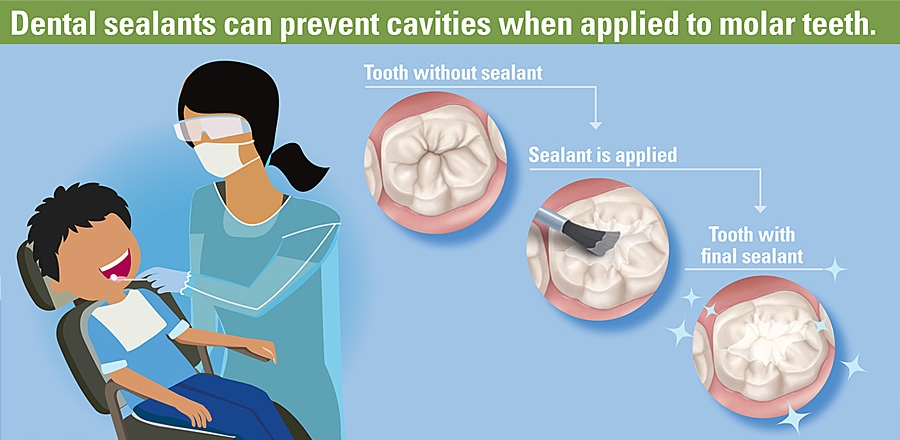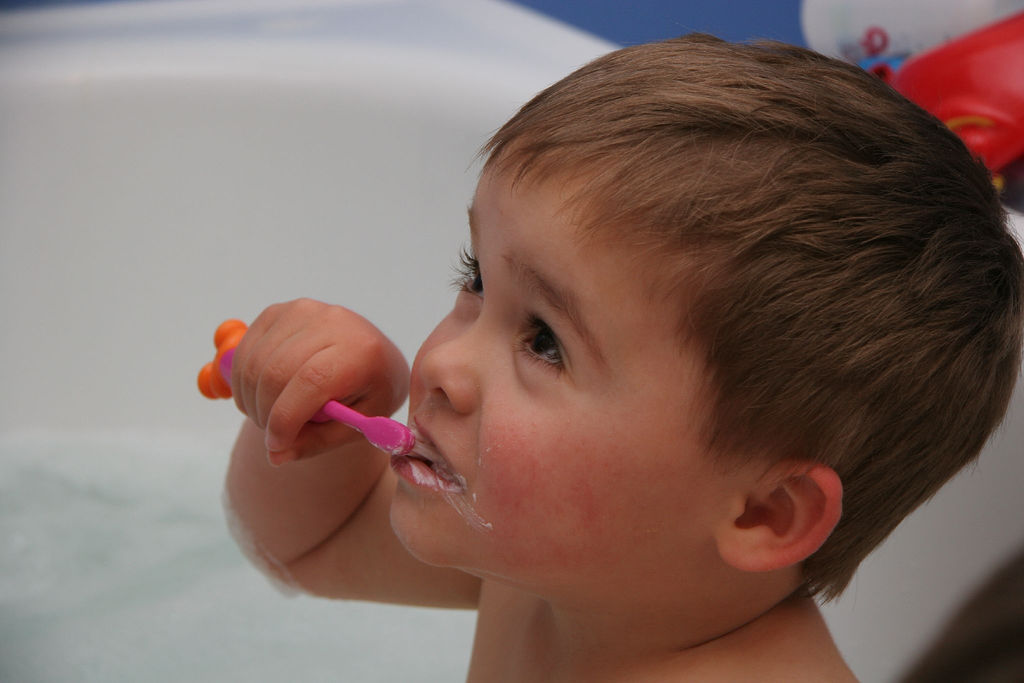If you have school-age children, you may have heard other parents discussing sealants. Dental sealants are a popular method of keeping cavities at bay. Many of your kids’ classmates may have had their dentists apply them. What exactly are dental sealants, and do your children need them too?
How Do Dental Sealants Work?
A dentist applies sealants to teeth like paint to the biting surface of the back teeth. In this case, the “paint” is actually a liquid plastic, or resin. The liquid fills in the tooth’s natural dips and grooves, where food can get stuck. The resin dries and hardens, forming a strong, clear barrier that keeps out the acids and bacteria that cause tooth decay. (For a more detailed explanation of the procedure, read What to Expect When Getting Sealants.)
It may take a few days to get used to having sealants. Since they smooth out the bumps on the teeth, they may feel a little odd at first. But they are thin and clear, and will soon be unnoticeable by the patient (or anyone else).
Safe, Painless, and Effective
Having dental sealants applied is safe, painless, and effective. Their ability to keep out cavity-causing decay makes them a popular choice for children. Research by the American Dental Association and the Centers for Disease Control agrees that they work. Studies show that they can reduce decay on the biting surfaces of teeth by as much as 70% over a five-year period. They also have found that school age children without sealants get three times more cavities than those who have sealants.
Extra Protection for Cavity-Prone Kids
Anyone can have sealants applied, but they are more widely suggested for children than adults. Children may be particularly cavity-prone, partly because they haven’t learned to brush and floss properly. Sealants can give added protection to their teeth.
In rare cases, a dentist might recommend sealants for baby teeth. More often, he or she will bring up the topic as the adult molars start to come in at around age six. Covering new adult teeth with sealants as soon as they emerge is the most common practice.
Sealants do not mean that you can stop taking your children to the dentist. They are not a 100% guarantee against getting cavities. Sealants are a precautionary measure that works along with regular dental checkups and good dental hygiene.

Addressing Your Concerns About Dental Sealants
As with most topics discussed by parents, there often some debate. A few misconceptions exist about sealants that make some parents think they are not a good idea.
1. Are Sealants Safe?
This myth stems from the fact that the plastic material used in dental sealants may include the synthetic compound BPA. BPA is found in many plastics and studies have shown that exposure to large amounts can be harmful. Sealants, however, have only tiny, trace amounts of the compound. The American Dental Association has found the amounts to be far below levels that would be considered unsafe. The ADA asserts that sealants are a safe and effective way to avoid cavities. You can read more about the results of their study here.
2. Can Cavities Grow Under Sealants?
If a sealant is put on over decay, it is true that a cavity can grow beneath it. But this is very rare. If you have a reputable dentist who has experience applying sealants, they will make sure they are applying the sealants to healthy teeth. A thorough exam including a cleaning and X-rays should be part of the procedure. If it’s not, you may want to find another dentist. Our online search tool can guide you to a dentist with knowledge and skill in the correct application of dental sealants.
3. Sealants Wear Out. Are They a Waste of Money?
It is true that sealants don’t last forever. On average, they work for five to ten years. For some people it’s more than ten. A few factors figure in to whether they are “worth it” for your children.
Cost – Since sealants aren’t a guarantee that your child won’t get a cavity, this is a bit of a guessing game. You will need to weigh the cost of getting sealants with the cost of filling potential cavities that your child might get. The price of sealants varies based on your region and your dentist. If you can avoid the cost, and your child’s pain, of even a few fillings, it may be worth it.
Heredity and habits – Your child’s chances of getting cavities depends on a few different factors. They may be particularly cavity-prone due to genetics, diet, or brushing habits. For those predisposed to tooth decay, sealants are a good option. Certain habits can help extend the life of their sealants if they do get them. Avoiding chewing on hard things like ice and not using teeth to open packages can help. Also, children who do not grind their teeth at night get more wear out of their sealants.
Are Dental Sealants Worth It?
The more you know, the better equipped you are to make any parenting decision. These articles will give you additional information that will help you review your options:
Only you can choose if your child is a good candidate for dental sealants. Know the facts and make an appointment when you’re ready.


